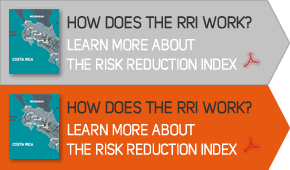Objectives
To increase resilience of most vulnerable populations.
The purpose of Risk Reduction Index is to generate knowledge that will help local administrations, national governments, and regional bodies to address the underlying risk drivers, make risk management more effective and, thereby, contribute to an increased resilience of most vulnerable populations. The RRI project has three main objectives:
- To inform and guide practitioners and policy-makers about drivers of risk and how they influence or contribute to the generation of risks within determined geographical areas;
- To define specific actions that will improve risk management at local, national and regional levels; and
- To generate baseline data for measuring progress (or setbacks) of how underlying risk drivers are addressed over time.
The RRI aims to influence development processes and promote better integration of disaster risk reduction (DRR) and climate change adaptation (CCA) into development and poverty reduction strategies and policies.
Outcomes
Effective policies and initiatives related to disaster risk reduction (DRR) and climate change adaptation (CCA).
By analysing the conditions and capacities for disaster risk reduction according to the four risk drivers identified, their specific influence on risk reduction will be determined and specific steps can thus be identified in order to define more effective policies and initiatives related to disaster risk reduction (DRR) and climate change adaptation (CCA).
In its initial study in Central America, the RRI has proven significant for the following reasons:
- It promotes a multi-stakeholder and inter-sectoral angle to risk management.
- It highlights the root causes of risks by identifying underlying risk factors.
- It offers a comprehensive overview of capacities and conditions and steps needed in order to pursue more comprehensive DRR and CCA strategies.
- It identifies aspects of development processes and institutional structures that need to be addressed in risk management.





Share this